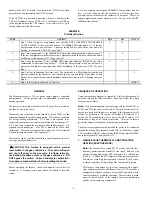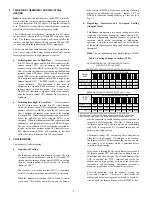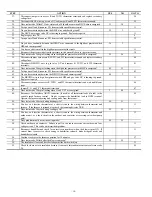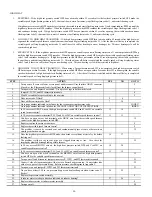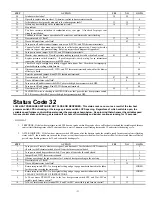
- 6 -
blower motor BLWM will remain ON until the main burners
ignite then shut OFF and remain OFF for the blower-ON delay
(60 seconds in low-heat, and 35 seconds in high-heat), allowing
the furnace heat exchangers to heat up more quickly, then
restarts at the end of the blower-ON delay period at low-heat or
high-heat airflow respectively.
The blower motor BLWM will revert to continuous-blower
airflow after the heating cycle is completed. In high-heat, the
furnace control CPU will drop the blower motor BLWM to
low-heat airflow during the selected blower-OFF delay period
before transitioning to continuous-blower airflow.
When the thermostat "calls for low-cooling", the blower motor
BLWM will switch to low-cooling airflow. When the
thermostat is satisfied, the blower motor BLWM will operate an
additional 90 seconds at low-cooling airflow before
transitioning back to continuous-blower airflow.
When the thermostat "calls for high-cooling", the blower motor
BLWM will switch to high cooling airflow. When the
thermostat is satisfied, the blower motor BLWM will operate an
additional 90 seconds at high-cooling airflow before
transitioning back to continuous-blower airflow.
When the R to G circuit is opened, the blower motor BLWM
will continue operating for an additional 5 seconds, if no other
function requires blower motor BLWM operation.
a. Continuous Blower Speed Selection from Thermostat
To select different continuous-blower airflows from the
room thermostat, momentarily turn off the FAN switch or
push-button on the room thermostat for 1-3 seconds after
the blower motor BLWM is operating. The furnace
control CPU will shift the continuous-blower airflow from
the factory setting to the next highest CF selection airflow
as shown in Table 1. Momentarily turning off the FAN
switch again at the thermostat will shift the continuous-
blower airflow up one more increment. If you repeat this
procedure enough you will eventually shift the continuous-
blower airflow to the lowest CF selection as shown in
Table 1. The selection can be changed as many times as
desired and is stored in the memory to be automatically
used following a power interruption.
7. HEAT PUMP DEFROST
When installed with a heat pump, the furnace control
automatically changes the timing sequence to avoid long blower
off times during demand defrost cycles. Whenever W/W1 is
energized along with Y1 or Y/Y2, the furnace control CPU will
transition to or bring on the blower motor BLWM at cooling
airflow, low-heat airflow, or the midrange airflow, whichever is
lowest. The blower motor BLWM will remain on until the
main burners ignite then shut OFF and remain OFF for 25
seconds before coming back on at heating airflow. When the
W/W1 input signal disappears, the furnace control begins a
normal inducer post-purge period while changing the blower
airflow. If Y/Y2 input is still energized the furnace control
CPU will transition the blower motor BLWM airflow to cooling
airflow. If Y/Y2 input signal disappears and the Y1 input is still
energized the furnace control CPU will transition the blower
motor BLWM to low-cooling airflow. If both the Y1 and Y/Y2
signals disappear at the same time, the blower motor BLWM
will remain on at low-heat airflow for the selected blower-OFF
delay period. At the end of the blower-OFF delay, the blower
motor BLWM will shut OFF unless G is still energized, in
which case the blower motor BLWM will operate at continuous
blower airflow.
8. COMPONENT
TEST
The furnace features a component test system to help diagnose
a system problem in the case of a component failure. To initiate
the component test procedure, ensure that there are no
thermostat inputs to the control and all time delays have
expired. Turn on setup switch SW1-6. (See Appendix A)
Note:
The component test feature will not operate if the control
is receiving any thermostat signals or until all time delays have
expired.
The component test sequence is as follows:
a. The furnace control CPU turns the inducer motor IDM ON
at medium speed and keeps it ON through step c.
b. After waiting 10 seconds the furnace control CPU turns
the hot surface igniter ON for 15 seconds, then OFF.
c. The furnace control CPU then turns the blower motor
BLWM on at midrange airflow for 15 seconds, then OFF.
d. After shutting the blower motor OFF the furnace control
CPU shuts the inducer motor IDM.
Note:
The EAC terminals are energized when the blower is
operating.
After the component test is completed, 1 or more status codes
(11, 25, 41, or 42) will flash. See Service Label on blower
access panel or Service/Status Code Instructions for explanation
of status codes.
Note:
To repeat component test, turn setup switch SW1-6 to
OFF and then back ON.


